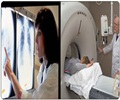A group of researchers has identified a narrow region on chromosome 15 that contains genetic variations linked to familial lung cancer.
A narrow region on chromosome 15 that contains genetic variations linked to familial lung cancer has been identified by a group of researchers.
Scientists at Washington University School of Medicine in St. Louis and other institutions in the United States and the United Kingdom found that people with these genetic variations and a family history of lung cancer are five times more likely to develop lung cancer.The risk was not affected by whether the study participants smoked or didn't smoke.
"Many smokers don't get lung cancer, which suggests there is a genetic difference in smokers who do get the disease," said senior author Ming You, M.D., Ph.D., a researcher in cancer chemoprevention at the Siteman Cancer Center at Washington University School of Medicine and Barnes-Jewish Hospital.
"We also know that some families have a high incidence of lung cancer. If we can identify the genetic factors linked to lung cancer in such people before they get the disease, we can take steps to help prevent it. This genetic region might be part of the answer," he added.
He said that among research groups studying lung cancer susceptibility, many other genetic markers of increased risk have been identified, but the area identified in this study on chromosome 15 is the only genetic region that is consistent across many studies.
The three recent studies on sporadic lung cancer cited an approximately 30 percent greater risk for individuals with specific genetic variations in this region of chromosome 15, a much lower risk than found in the current study.
Advertisement
"It would suggest that specific genes in this region and smoking are independent risk factors for lung cancer, and together they might cause an even greater increase in lung cancer risk," he added.
Advertisement
The team found several genetic variants with a strong association to familial lung cancer on chromosomes 1, 3, 6, 9, 12 and 20, but a cluster on the long arm of chromosome 15 had the strongest link to the disease.
The findings are published in the Journal of the National Cancer Institute.
Source-ANI
RAS/L















